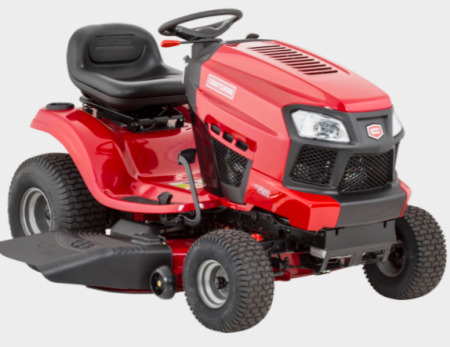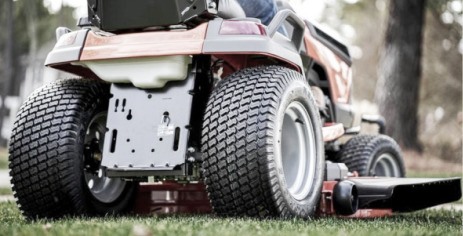________________________________________________________________________________________
Craftsman T2500 Troubleshooting
 The
Craftsman T2500 lawn tractor was manufactured between 2014 and 2016. The
Craftsman T2500 powertrain system components: 32.9 cu.in (540 cc) Briggs and
Stratton 33R877 4-cycle vertical-shaft single cylinder air-cooled gasoline
engine with a rated power of 19 hp (14.2 kW), and CVT Automatic transmission
with infinite forward and reverse gears.
The
Craftsman T2500 lawn tractor was manufactured between 2014 and 2016. The
Craftsman T2500 powertrain system components: 32.9 cu.in (540 cc) Briggs and
Stratton 33R877 4-cycle vertical-shaft single cylinder air-cooled gasoline
engine with a rated power of 19 hp (14.2 kW), and CVT Automatic transmission
with infinite forward and reverse gears.
The engine has a float-feed carburetor, integral type fuel pump, full
pressure lubrication with full-flow oil filter, and cartridge type air
cleaner. Max. travel speed (forward/reverse): 5.5 mph (8.8 km/h) and 2.3
mph (3.7 km/h).
The Craftsman T2500 was equipped with a manual steering system,
mechanical disc brakes, 15x6.00-6 front tires, and 20x8.00-8 rear tires.
The wheelbase is 48 in (1210 mm). The tractor is compatible with a 46"
mid-mount 2-blade mower deck with cutting height of 1.0-4.0 in (25-100
mm), 6 cut positions, and mechanical lifting system.
| Engine Troubleshooting |
| Engine difficult to start or doesn't start |
| Gas tank is empty - Add fuel |
| Low-quality gasoline - Change fuel |
| Air in the fuel system - Air bleeding |
| Faulty spark plug wire connection - Check the spark plug wire connection, repair or replace |
| Defective spark plug - Install new spark plug |
| Fuel filter is dirty - Change fuel filter |
| Safety contact for brake pedal defective - Install new part |
| Carburetor is dirty - Wash, clean and adjust |
| Poor cylinder compression - Check cylinder block and change worn parts |
| Damaged or not adjusted choke cable - Replace cable or adjust properly |
| Air intake screen is blocked - Clean and wash as required |
| Ignition system malfunction - Inspect ignition system and change faulty parts |
| Stuck or faulty choke cable - Clean or replace the cable |
| Dirty air filter element - Service or replace air filter |
| Fuel pump is clogged or faulty - Test fuel pump and replace if necessary |
| Engine stalls after starting |
| Spark plug is defective - Change spark plug as required |
| Carburetor is dirty or defective - Service or repair carburetor |
| Damaged ignition coil - Change ignition coil as required |
| Loose or broken valve springs - Valve springs need to be changed |
| Valves sticking - Service the valves |
| Engine oil insufficient - Add oil to the engine crankcase |
| Engine overloaded - Load reducing is recommended |
| Plugged cooling fins - Wash or clean as required |
| Carburetor fuel mixture is too lean - Set the carburetor properly |
| Ignition timing is improper - Adjust ignition timing as required |
| Valve setting is incorrect - Adjust valves as required |
| Stale gasoline - Change fuel |
| Excessive engine load - Reduce the load |
| Lack of engine oil - Fill the crankcase with engine oil |
| Too low idle RPM - Adjustment required |
| Fuel pump is dirty or defective - Test fuel pump and replace if necessary |
| Crankshaft or main bearings failure - Install new parts as as required |
| Valve clearance is improper - Adjust valve clearance |
| Damaged cylinder bore or piston rings - Change defective components |
| Improperly adjusted or dirty carburetor - Clean or correctly adjust carburetor |
| Air filter element is clogged - Clean or change air filter |
| Dirty or damaged fuel pump - Check fuel pump and change if required |
| Defective ignition - Inspect ignition system and change failed components |
| Cylinder head gasket is damaged - Install new head gasket |
| Valves are burned or stuck - Change or clean valves |
| Push rod is damaged or worn - Push rod needs to be changed |
| Cylinder block parts are damaged - Change defective parts |
| Excessive fuel consumption |
| Choke did not open fully - Change or adjust choke cable |
| Incorrect carburetor main jet adjustment - Adjust the carburetor main jet properly |
| Loose or defective spark plug - Spark plug need to be tightened or replaced |
| Burned, worn, or stuck valves - Change or clean valves |
| Worn rings, piston, or sleeve - Replace defective components as required |
| Valve clearance is improper - Need to adjust valve clearance |
| Engine consuming too much oil |
| Worn seals or gaskets - Replace to repair leaks |
| Worn valve guides and valve stems - Need to replace the valves |
| Piston rings are stuck or worn - Have piston rings replaced |
| Piston or cylinder liner is damaged - Check piston and liner, install new parts as required |
| Breather hose or pipe is blocked - Change or clean |
| Transmission Troubleshooting |
| Difficulty shifting gears |
| Gear shift linkage is damaged or loose - Replace or service the shift linkage |
| Shift forks are worn or damaged - Replace defective shift forks |
| Worn parts of the gear shifting mechanism - Change worn parts |
| Transmission is excessively noisy |
| Fluid level is low - Check and refill the transmission fluid |
| Transmission fluid contamination - Change transmission fluid |
| Damaged gears or bearings - Replace bearings or gears |
| Transmission jumps out of gear |
| Improperly installed or damaged shifting lever - Replace or install shift lever correctly |
| Worn or damaged gear teeth - Replace defective gears |
| Shift forks or shift rods are faulty - Replace defective rods or forks |
| Drive belt/shaft is defective or improperly adjusted - Adjust or replace belt/shaft |
| Clutch/brake is incorrectly adjusted or defective - Adjust clutch/brake or install a new one |
| Drive sheave is damaged or worn - Install a new sheave |
| Hydrostatic Transmission Troubleshooting |
| Excessive hydrostatic transmission noise |
| Worn or unadjusted speed control linkage - Change or adjust linkage |
| Transmission is under excessive load - Reduce transmission load |
| Transmission oil is contaminated or oil level is insufficient - Fill to required level or change the transmission oil |
| Transmission parts are worm or defective - Check hydrostatic transmission components for defect or damage and change if necessary |
| Stuck or damaged gshift linkage - Replace or repair the linkage |
| Hydrostatic pump is stuck or worn - Repair or change pump |
| Defective or unadjusted transmission shift control components - Change or adjust correctly |
| Transmission fluid insufficient - Check and refill the transmission fluid |
| Drive sheave is defective or worn - Install a new sheave |
| Misadjusted or faulty shifting linkage - Adjust correctly or change linkage |
| Defective or not adjusted speed control pedal linkage - Adjust or repair linkage |
| Worn transmission seals or gaskets - Change seals or gaskets |
| Final drive shaft leakage - Install new shaft seals |
| Transmission case is cracked - Replace case or transmission assembly |
| Mower Deck Troubleshooting |
| Mower vibration is excessive |
| Dirty or worn mower drive sheave - Service or change sheave |
| Drive belt is worn or loose - Adjust belt tension or change the belt |
| Bent or unbalanced mower blades - Balance or replace blades |
| Loose blade mounting bolts - Tighten bolts as required |
| Constant clogging of discharge chute |
| High mowing speed - Use a slower speed |
| Tall grass - Adjust mower to lower cutting height |
| Engine rpm is too low - Adjust throttle to full opening |
| Mower cuts too low - Use correct cutting height |
| Mower drive belt installation is improper - Install drive belt as required |
| Discharge chute is plugged - Mower deck needs to be cleaned |
| Blades are not sharp - Sharpen the blades |
| Worn or damaged blades - Change the blades |
| Ground speed is too fast - Use a slower speed |
| Cutting level is too low - Must be set to high cutting height |
| Grass bag is full - Remove grass from bag |
| Lawn is not level or bumpy - Lawn needs to be leveled |
| Mower deck set to low cutting - Use a higher cutting height |
| Fast ground speed - Select a slower speed |
| Incorrectly leveled mower deck - Adjust mower deck level properly |
| Damaged or bent blades - Change the blades |
| Low tire inflation - Inflate tires as required |
| Tires are not properly inflated - Check and inflate the tires |
| Deck level is not correct - Adjust the level of mower deck correctly |
| Blades are excessively dull - Need a blade sharpening |
| Worn or bent blades - Change the blades |
| Deck is plugged with grass - Clean out the mower deck |
| Broken mower deck housing - Repair or replace the deck |
| Bent or loose mower spindle - Repair or change the spindle |
| Electrical Troubleshooting |
| Battery will not charge |
| Electrical cable connections are corroded or loose - Service or tighten connections |
| Defective battery terminal clamps - Terminal clamps need to be replaced |
| Battery failing - Install a new battery |
| Starter motor cranks slow |
| Low battery output voltage - Battery needs to be recharged |
| Battery runs out quickly - Service battery or replace it |
| Disconnected wiring or bad battery terminals - Check cable connections and replace or service terminals |
| Battery is low or faulty - Charge or change the battery |
| Disconnected or incorrectly connected wires - Inspect battery wires and connect correctly |
| Battery voltage is low - Battery is drained, recharge it |
| Spark plug gapped improperly or faulty - Clean, gap or change spark plug |
| Solenoid or starter motor is faulty - Repair starter or replace solenoid |
________________________________________________________________________________________
________________________________________________________________________________________
| Lawn and Garden Tractors Technical Specs |
 The
Craftsman T2500 lawn tractor was manufactured between 2014 and 2016. The
Craftsman T2500 powertrain system components: 32.9 cu.in (540 cc) Briggs and
Stratton 33R877 4-cycle vertical-shaft single cylinder air-cooled gasoline
engine with a rated power of 19 hp (14.2 kW), and CVT Automatic transmission
with infinite forward and reverse gears.
The
Craftsman T2500 lawn tractor was manufactured between 2014 and 2016. The
Craftsman T2500 powertrain system components: 32.9 cu.in (540 cc) Briggs and
Stratton 33R877 4-cycle vertical-shaft single cylinder air-cooled gasoline
engine with a rated power of 19 hp (14.2 kW), and CVT Automatic transmission
with infinite forward and reverse gears.